Mohs micrographic surgery (also known as Mohs chemosurgery) is a state-of-the-art treatment for skin cancer in which the diseased area is removed with the accuracy and precision of a microscope. Of all techniques to remove skin cancer, Mohs micrographic surgery has the highest cure rate and minimizes the extent of scarring. Mohs surgery is a one day, outpatient treatment which is generally reserved for use only with certain skin cancers. Skin cancers that are large, have recurred following conventional treatment, or those found in certain anatomic locations such as the central face are very effectively treated with this technique. Mohs surgery is utilized most often for the treatment of basal cell carcinoma, squamous cell carcinoma, and lentigo maligna (an early form of melanoma usually occurring on the face). However, the Mohs technique is also useful for other, less common forms of skin cancer, including sebaceous carcinoma, merkel cell carcinoma, atypical fibroxanthoma, microcystic adnexal carcinoma and dermatofibrosarcoma protuberans.
In the Mohs micrographic method, the doctor serves as surgeon, pathologist, and reconstructive surgeon. The technique, created by Dr. Frederick Mohs, is as follows:
Preparation for Mohs Micrographic Surgery
Prior to surgery, we recommend that patients get a full night’s sleep and (unless told otherwise) eat a light breakfast. The procedure is performed entirely on an outpatient basis in our office. The laboratory work involved in preparing the tissue for microscopic interpretation is labor-intensive and can take up to 1 – 2 hours or more to complete for each layer. Most patients bring a book or something to do while waiting on the results. We ask each patient to plan to spend the rest of the day with us, but some patients may be finished earlier.
If you are known to have cardiovascular disease and have been prescribed aspirin, or Coumadin by your physician, it is not necessary to discontinue it, unless you are told otherwise. If you have not been prescribed aspirin or other blood thinners by your physician for the treatment of known cardiovascular disease, avoid aspirin for at least 7 days prior to surgery and for 2 – 3 days after surgery. All patients should try to avoid other NSAID’s (non-steroidal anti-inflammatory drugs), such as Advil/Motrin/ibuprofen, Naprosyn/Aleve/naproxen, and similar medications, and vitamin E as these medications also increase the tendency of bleeding. Plain Tylenol may be taken if pain medicine is needed. Be sure to check with your primary care physician prior to discontinuing any prescribed medications. A patient should also not drink any alcoholic beverages for two days before surgery and for one to two days afterwards.
Preoperative Instructions for Mohs Micrographic Surgery or Excisional Surgery
Your Recovery – Return To Health And A Healthy Lifestyle
Immediately after surgery and during the recovery period, there will often be the sensation of tightness as well as soreness of the treated area. The area can also become very swollen and bruised depending on the extent of involvement. A variable degree of transient numbness of the area is generally expected due to nerve involvement, but complete and permanent loss of nerve function is rare. The incision line(s) typically improve in appearance over the first three to six months postoperatively, especially if exposure to the sun is avoided. Because the Mohs surgeon removes only the diseased tissue and as little healthy tissue as possible, the extent of scarring (which normally occurs after any surgery) is kept to a minimum.
It is important that patients take every precaution following Mohs micrographic surgery for skin cancer. In particular, adhering to a strict sun avoidance program helps to reduce the risk of further skin cancers. It is also important that patients be carefully monitored on a regular basis by their primary dermatologist after surgery. Research has shown that if there is a recurrence of skin cancer, it usually occurs within the first year. Furthermore, a significant percentage of patients who develop one skin cancer will get another within the next five years. Prevention and early detection are key.

Click here for more information about our affiliate – Skin Cancer Specialists Surgery Center, LLC.
WARNING: Gallery contains graphic images
